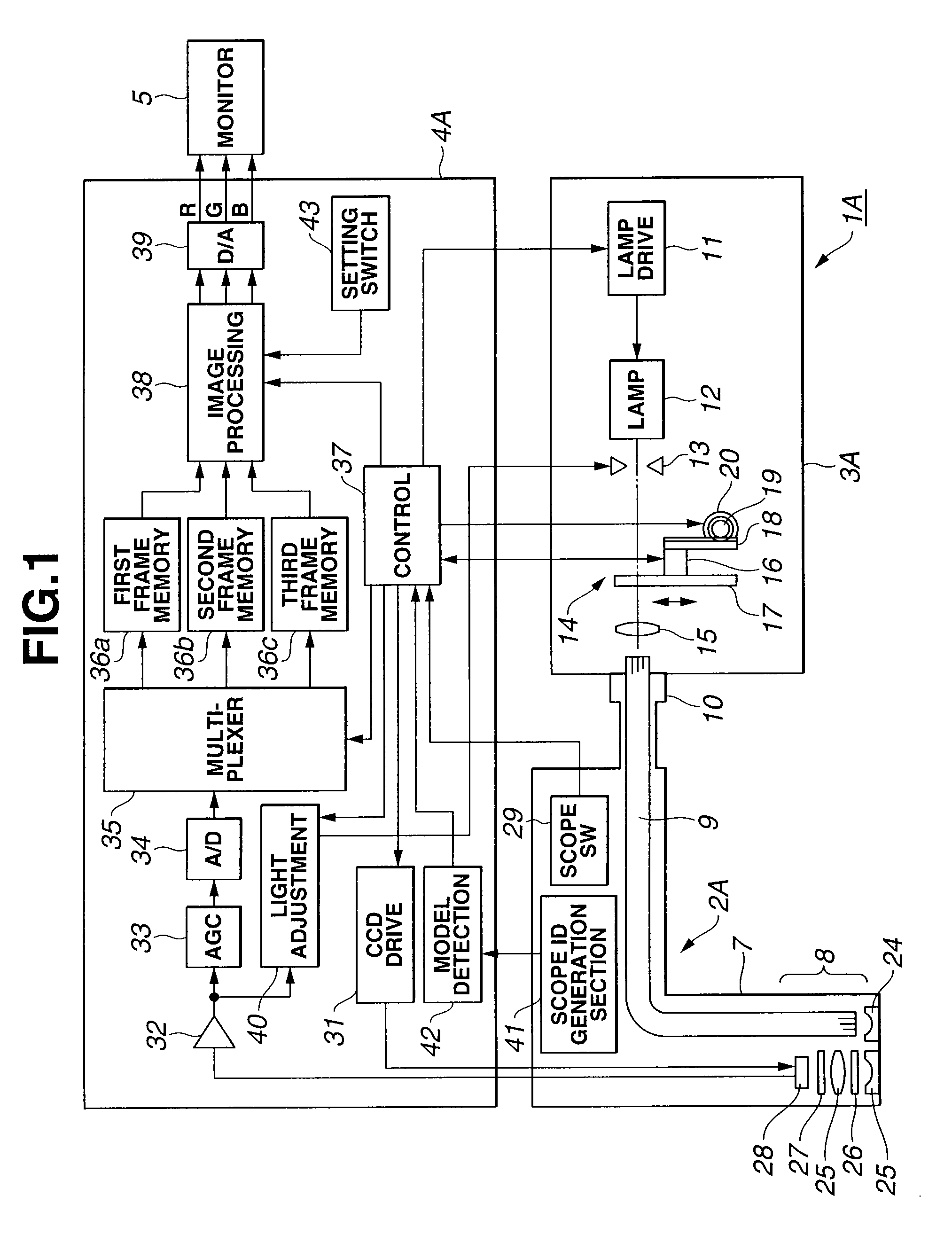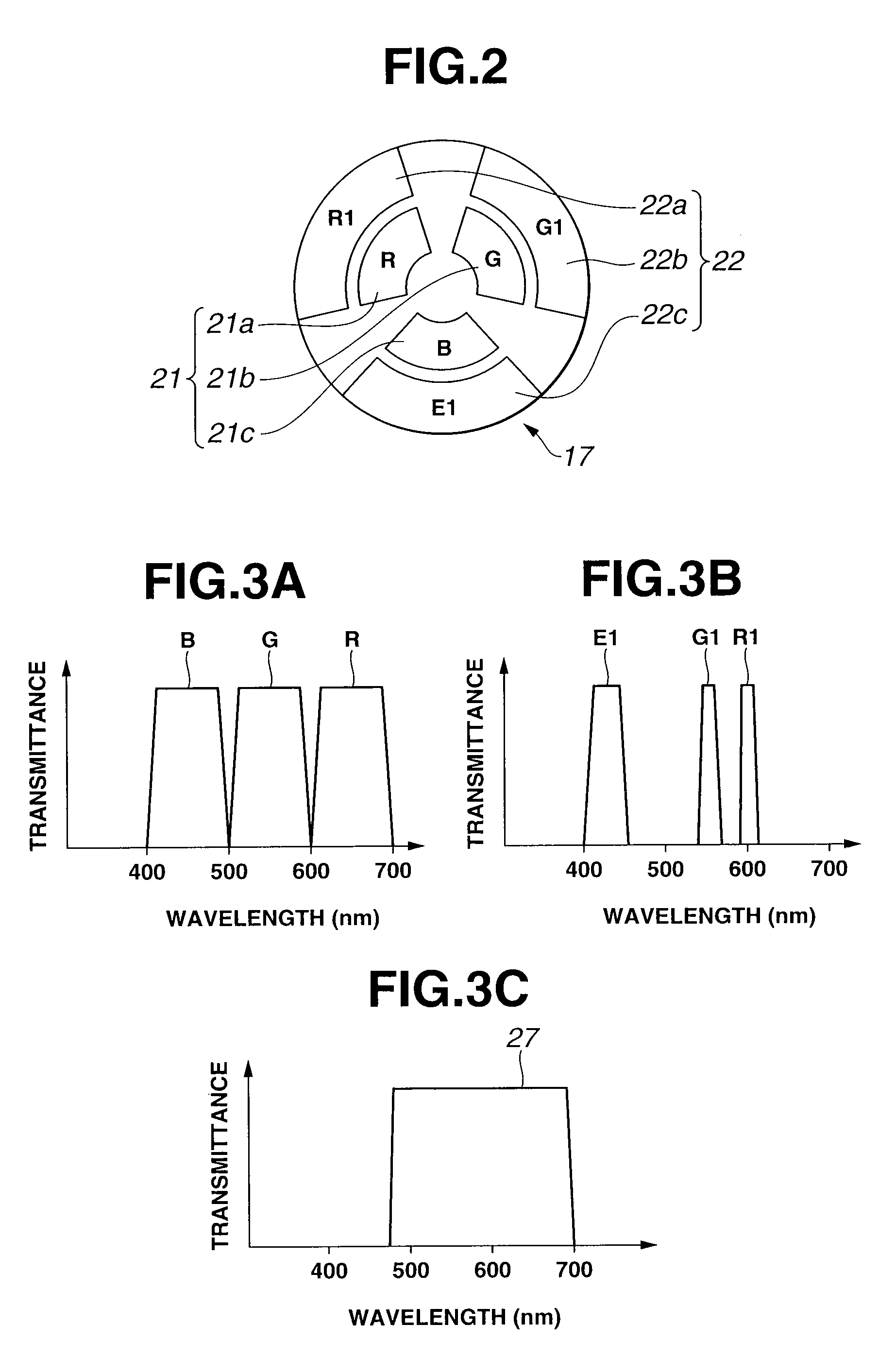Endoscope system using normal light and fluorescence
a technology of endoscope and fluorescence, which is applied in the field of endoscope system using normal light and fluorescence, can solve the problems of insufficient identification function between normal tissue and pathologically affected tissue, difficult identification of pathologically affected tissue and normal tissue in some cases, etc., and achieves the effect of simple configuration and easy identification of normal tissue and pathologically
- Summary
- Abstract
- Description
- Claims
- Application Information
AI Technical Summary
Benefits of technology
Problems solved by technology
Method used
Image
Examples
first embodiment
[0062] The first embodiment of the present invention will be described with reference to FIG. 1 to FIG. 15.
[0063] The endoscope system 1A, which has a normal-light observation mode and a fluorescent observation mode according to the first embodiment of the present invention shown in FIG. 1, comprises an electronic endoscope 2A which is inserted into a body cavity for observation, a light source unit 3A for emitting a light for normal-light observation and a light for excitation, a processor 4A for executing signal processing to create normal-light observation images and fluorescent images, and a monitor 5 for displaying images by normal light and images by fluorescence.
[0064] The electronic endoscope 2A has an elongated insertion section 7 which is inserted into a body cavity, and has illumination means and image capturing means which are enclosed in a tip 8 of the insertion section 7.
[0065] In the insertion section 7, a light guide fiber 9, for transmitting (guiding) excitation ...
second embodiment
[0188] The second embodiment of the present invention will now be described with reference to FIG. 16. The configuration of the present embodiment is the same as the first embodiment, wherein a part of the characteristics of the excitation light cut filter 27, shown in FIG. 3C, has been changed.
[0189]FIG. 16 shows the characteristics of the intensity with respect to the wavelength of fluorescence obtained from a biological tissue which includes porphyrin. As FIG. 16 shows, when the biological tissue includes porphyrin, a wavelength band slightly longer than 620 nm may have a peak, which emits fluorescence due to porphyrin.
[0190] According to the present embodiment, to eliminate this influence of fluorescence generated by porphyrin, the longer wavelength side of the transmission characteristic of the excitation light cut filter 27 is cut at 620 nm, as indicated by the one-dotted line in FIG. 16, so that fluorescence at a wavelength longer than this wavelength is not received by the...
third embodiment
[0193]FIG. 17 shows the image processing circuit 38D of the third embodiment.
[0194] In this image processing circuit 38D, an enhancement conversion table 56, comparator 57, and ROM 58 are additionally installed to the configuration in FIG. 4.
[0195] According to the present embodiment, the enhancement conversion table 56 is installed between the input end Tc and the matrix circuit 45 in FIG. 4, and the signal EX of the fluorescent image is enhancement-processed by this enhancement conversion table 56, and is input to the matrix circuit 45.
[0196] The input ends Ta and Tb are connected to the matrix circuit 45, and are connected to the comparator 57, and by this comparator 57, it is detected whether the signals R1 and G1, to be input from the input ends Ta and Tb, deviate from a predetermined range, and the detection signal is input to the ROM 58 installed between the matrix circuit 45 and the range correction tables 46a to 46c.
[0197] The ROM 58 compares the luminance level of sign...
PUM
 Login to View More
Login to View More Abstract
Description
Claims
Application Information
 Login to View More
Login to View More - R&D
- Intellectual Property
- Life Sciences
- Materials
- Tech Scout
- Unparalleled Data Quality
- Higher Quality Content
- 60% Fewer Hallucinations
Browse by: Latest US Patents, China's latest patents, Technical Efficacy Thesaurus, Application Domain, Technology Topic, Popular Technical Reports.
© 2025 PatSnap. All rights reserved.Legal|Privacy policy|Modern Slavery Act Transparency Statement|Sitemap|About US| Contact US: help@patsnap.com



